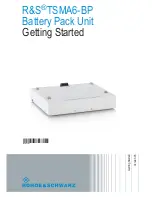
5
Charging Stages:
Stage 1 – “Desulphation”
In this initial start-up stage, a high frequency voltage pulse (0.5 sec) is to assist in “waking
up” a deeply discharged battery. This method of pulse charging can also help to reduce
build-up of sulphate crystals that may have formed on the battery plates during the time it
was discharged. This stage will last as long as it takes the battery to reach approximately
10 volts. If the connected battery is only slightly discharged, this stage may only be activated
for a short time before automatically switching to the next “soft start” stage.
Stage2 – “Soft Start”
After the battery is connected, most conventional “Smart” Battery Chargers will immediately
apply a high charging voltage and current output. This creates a large amount of gas and
heat from the battery and when the consistency of the battery electrolyte / state of cell charge
is uneven - (from time to time the consistency of the battery electrolyte can be uneven from
daily use) - a full load charging characteristic can result in a period of potentially damaging
overcharging.
The Soft Start function eliminates this situation by starting the charging process slowly and
softly, battery electrolyte and cell charge is able to even out, before receiving the main bulk
charge. This significantly improves the battery charging capability and reception.
Stage 3 – “Bulk”
This is the main hard charging stage, where the charger will operate at the maximum rated
current output, until the battery reaches a pre-set voltage determined by the battery type
selection. Charging time period is determined by the capacity and charge state of the
battery.
Stage 4 – “Absorption”
After the Bulk stage, the charger will automatically begin to reduce its current output
depending on the charge acceptance of the battery, while maintaining a constant voltage
(determined by the battery type selection). When the current reduces to a predetermined
threshold level charging will automatically halt, allowing the analysis stage to be performed
Stage 5 - “Analysis”
(Testing the battery while charging)
After the Absorption charging state, the battery charger will start the “Analysis” stage and
will stop charging the battery for approximately 2 minutes. At this point, if the battery voltage
is sensed at below 12.6V, the battery alarm and faulty battery indicators and alarm will
sound. If the battery voltage is equal to or above 12.6V, the next Boost stage will start.
Stage 6 – “Boost”
After successfully analysing the battery condition, the charger will enter the Boost charge
stage, which will charge at a slightly higher voltage ensuring the battery attains a 100% full
charge. The current output is limited at 25% of the maximum rated charger output. When
the current drops to the pre-set level or a maximum of 15 minutes is reached the charger
will enter the last float charge stage.


























